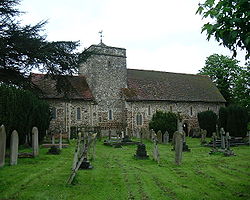- Church of St Laurence, Upton-cum-Chalvey
-
Church of Saint Laurence, Upton-cum-Chalvey 
Country United Kingdom Denomination Church of England Website St Laurence website Administration Parish Upton-cum-Chalvey Diocese Oxford Clergy Pastor(s) Andrew Allen Saint Laurence's Church is one of three churches in the modern parish of Upton-cum-Chalvey, and is the oldest building in the borough of Slough, in Berkshire, England.
In the 12th century the wooden parish church of Upton was replaced with a flint building. The tower and outside walls of the Norman building form part of the present church. Several walls bear testament to pudding stone construction. Two other Norman features survive: the ancient baptismal font, and a piscina. During the reformation, many of the ancient decorations were mutilated. A 13th century Italian allegorical image of the Trinity – God Father, Son and Holy Spirit – survived and was reassembled during the restoration of the church.
Dereliction and restoration
By the early 19th century the church had fallen into such disrepair that it was decided to build a new church, Saint Mary’s, in the town centre. The Norman building was saved from demolition by a local farmer who secured the outside walls and tower. Saint Laurence’s was restored during 1850–1851 and rededicated on 2 December 1851.
Famous associations with the church
The churchyard may have inspired the 1751 Elegy Written in a Country Churchyard by local poet Thomas Gray (1716–1771). St Laurence’s "ivy-mantled tow’r" was a well-known landmark housing a curfew bell that "tolls the knell of parting day" across the fields of Eton College.
The church is the final resting place of Slough astronomer Sir William Herschel (1738–1822), the discoverer of Uranus, and also of his wife and his grandson Alexander Herschel. They are all interred in a family vault at the base of the tower, and commemorative plaques may be seen on the wall nearby. In 2001, a generous bequest allowed St Laurence's to install an impressive set of stained-glass windows to commemorate Herschel and his discovery.
The west window of the church is a memorial to John Sullivan (1788–1855), who is buried in the churchyard. He was the Collector of Coimbatore, India, between 1815 and 1830, and is best known as the founder of the city of Ooty. Charles Hatchett (1765–1847), discoverer of niobium, is also buried here.
The current organist is the poet and translator Keith Bosley.
External links
Categories:- Church of England churches in Berkshire
- Diocese of Oxford
- Grade I listed buildings in Berkshire
- Grade I listed churches
- Buildings and structures in Slough
Wikimedia Foundation. 2010.
